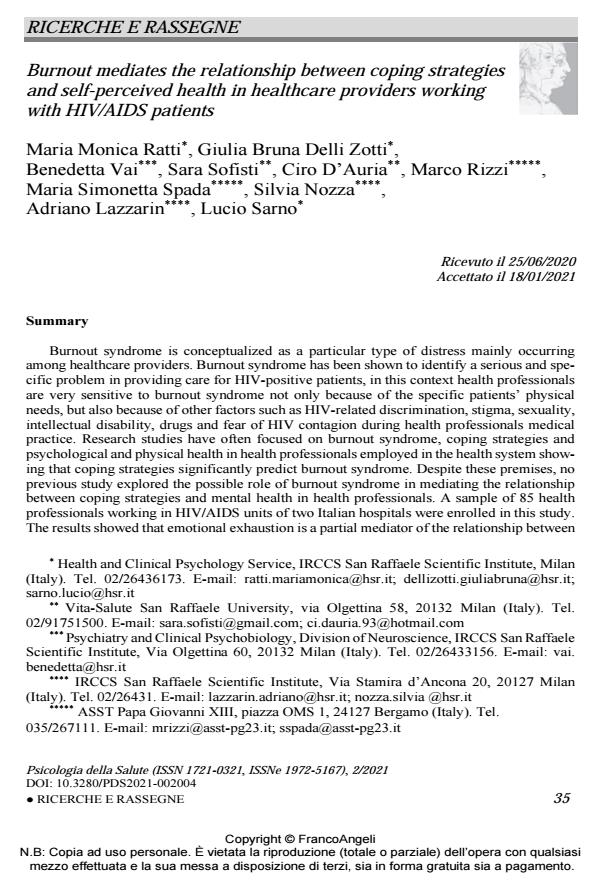Burnout mediates the relationship between coping strategies and self-perceived health in healthcare providers working with HIV/AIDS patients
Journal title PSICOLOGIA DELLA SALUTE
Author/s Maria Monica Ratti, Giulia Bruna Delli Zotti, Benedetta Vai, Sara Sofisti, Ciro D’Auria, Marco Rizzi, Maria Simonetta Spada, Silvia Nozza, Adriano Lazzarin, Lucio Sarno
Publishing Year 2021 Issue 2021/2
Language English Pages 19 P. 35-53 File size 412 KB
DOI 10.3280/PDS2021-002004
DOI is like a bar code for intellectual property: to have more infomation
click here
Below, you can see the article first page
If you want to buy this article in PDF format, you can do it, following the instructions to buy download credits

FrancoAngeli is member of Publishers International Linking Association, Inc (PILA), a not-for-profit association which run the CrossRef service enabling links to and from online scholarly content.
Burnout syndrome is conceptualized as a particular type of distress mainly occurring among healthcare providers. Burnout syndrome has been shown to identify a serious and spe-cific problem in providing care for HIV-positive patients, in this context health professionals are very sensitive to burnout syndrome not only because of the specific patients’ physical needs, but also because of other factors such as HIV-related discrimination, stigma, sexuality, intellectual disability, drugs and fear of HIV contagion during health professionals medical practice. Research studies have often focused on burnout syndrome, coping strategies and psychological and physical health in health professionals employed in the health system show-ing that coping strategies significantly predict burnout syndrome. Despite these premises, no previous study explored the possible role of burnout syndrome in mediating the relationship between coping strategies and mental health in health professionals. A sample of 85 health professionals working in HIV/AIDS units of two Italian hospitals were enrolled in this study. The results showed that emotional exhaustion is a partial mediator of the relationship between emotional coping and mental health status; so, we can assume that structured interventions aimed to improving both emotional coping and burnout syndrome could improve mental health status. All these results underline the importance of health promotion and disease prevention initiatives for health professionals.
Keywords: Burnout syndrome; emotional exhaustion; quality of life; healthcare providers; coping; HIV.
Maria Monica Ratti, Giulia Bruna Delli Zotti, Benedetta Vai, Sara Sofisti, Ciro D’Auria, Marco Rizzi, Maria Simonetta Spada, Silvia Nozza, Adriano Lazzarin, Lucio Sarno, Burnout mediates the relationship between coping strategies and self-perceived health in healthcare providers working with HIV/AIDS patients in "PSICOLOGIA DELLA SALUTE" 2/2021, pp 35-53, DOI: 10.3280/PDS2021-002004